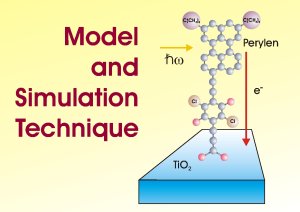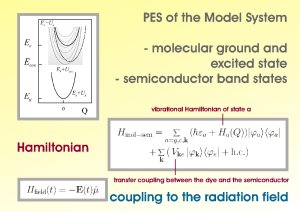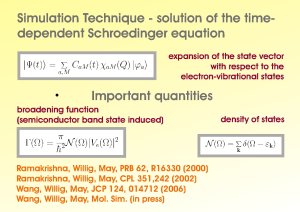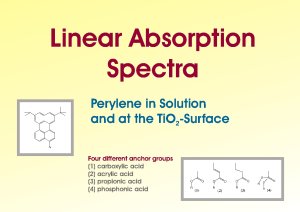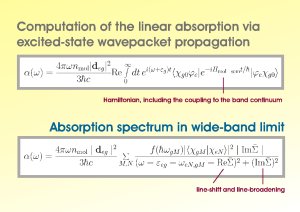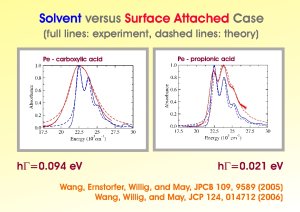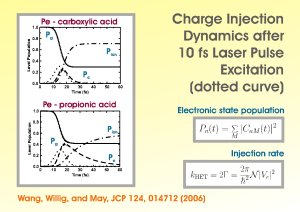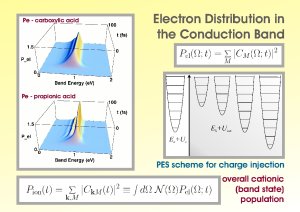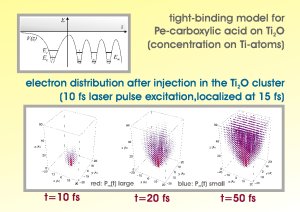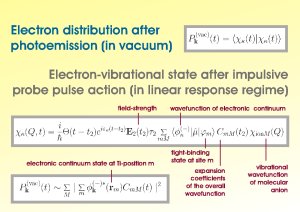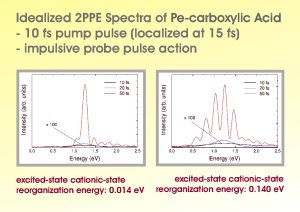Heterogeneous Electron Transfer
Electron transfer (ET) represents a ubiquitous phenomenon in physics,
chemistry, and biology which has attracted considerable interest over
the last six decades.
Heterogeneous electron transfer (HET) is a general phenomenon in
catalytic reactions, in electrochemistry, and in
photo electrochemistry. Since more than two decades there is a
continuing effort towards developing the field of molecular
electronics, where HET
will play a key role. HET has also been studied in nano-hybrid systems
mostly with the primary concern of developing a practical application.
Since HET reveals
unique properties of the electron
transfer process it can be considered also a research topic in its own
rights.
Ultrafast heterogeneous electron transfer (HET) between a molecule attached
to
a semiconductor surface and the conduction band of the semiconductor
is discussed theoretically with emphasis on the perylene TiO_2 system.
The used description accounts for the specialty of
the molecule i.e. its particular electronic level scheme together with its
vibrational
degrees of freedom. The band continuum of
the semiconductor is included and the approach is ready to describe
different optical excitation and detection processes. Using a
diabatic-state like separation of the whole system into molecular and
semiconductor
states femtosecond photoinduced dynamics are studied. Since the HET is
ultrafast
standard rate theories cannot be applied. Instead, the respective
time-dependent Schrödinger equation governing the electron-vibrational wave
function is solved.
Based on this approach and using a time-dependent formulation the steady
state linear
absorption is calculated. Parameters of perylene attached to nano-structured
TiO_2 via
different bridge-anchor groups are adjusted by a comparison with measured
spectra.
A direct charge transfer excitation into the
conduction band continuum is included into the description. This
time-dependent
formulation of the absorbance
is confronted with a direct formulation in the frequency domain using the
molecular
Green's function. It is also explained how to observe the energetic
distribution of the
injected electron which
carries signatures of the molecular vibrations in a two-photon photon
emission
spectrum.
Literature
- S. Ramakrishna, F. Willig, and V. May:
Photoinduced Ultrafast Electron Injection from a Surface Attached Molecule:
Control of Electronic and Vibronic Distributions via Vibrational Wave
Packets,
Phys. Rev. B. 62 R16330 (2000).
- S. Ramakrishna, F. Willig, V. May, and A. Knorr
Femtosecond Spectroscopy of Heterogeneous Electron Transfer:
Extraction of Excited State Population Dynamics from Pump-Probe Signals,
J. Phys. Chem. B 107, 607 (2003).
- L. Wang, R. Ernstorfer, F. Willig, and V. May:
Absorption Spectra related to Heterogeneous Electron Transfer Reactions:
The Perylene-TiO2 System,
J. Phys. Chem. B 109, 9589 (2005).
- L. Wang, F. Willig, and V. May:
Theory of Ultrafast Heterogeneous Electron Transfer:
Contributions of Direct Charge Transfer Excitations to the Absorbance,
J. Chem. Phys. 126 134110 (2007).
- L. Wang, V. May, R. Ernstorfer, J. Gundlach and F. Willig:
Ultrafast Photoinduced Electron Transfer
from Anchored Molecules into Semiconductors,
in "Analysis and Control of Ultrafast Photoinduced Reactions",
O. Kühn, L. Wöste, ed.
Springer Series in Chemical Physics Vol. 87
(Springer-Verlag, 2007), p. 437.
